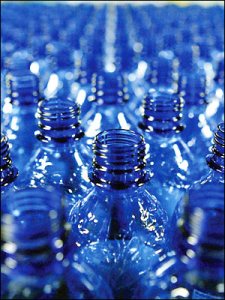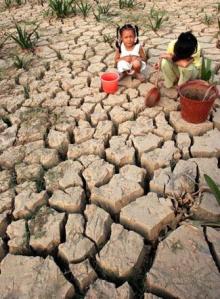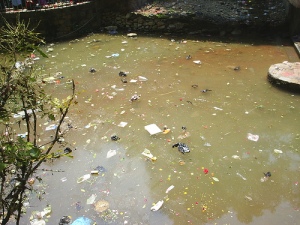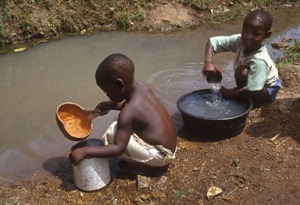During the fall of 2010 I lived in Tanzania, Africa. I worked as a legal intern at the International Criminal Tribunal for Rwanda and learned a lot about international criminal law. However, I didn’t want to spend my months there just working (even though I ended up actually working nights and weekends quite often). I tried to learn something about the culture there as well, I tried to get to know some locals and make some friends – and I succeeded. I volunteered in an orphanage during some Saturdays, and I also helped out some people I met there who didn’t have any possessions at all, let alone a job or money for food. In particular I had this one really good friend there, with whom I worked and who taught me a lot about the culture there. We talked about nearly everything, and we also disagreed on nearly everything. But we both enjoyed our conversations, so we kept on debating! I kept a blog for the period I was there, called Interning Tanzania, but I wanted to share with you some interesting facts about Tanzania. While being there I really truly realized how lucky I am to having been born in such a Westernized country, with all its possibilities.
The following is a blog post I wrote on October 10th 2010:
I’ve come to learn quite a lot about the position of women here in Tanzania. It is interesting to hear about life here, but it is shocking to realize that people here actually think men and women are equally treated here. To those who think that, equal has a totally different meaning from what I’m used to. To me it’s discrimination as soon as there’s a difference in treatment only because of what sex the person is. But here, it’s fair treatment to treat women and men differently, with the claim that God made men and women different for a reason, and the sexes can never be completely equal.
Before saying anything else I really want to thank my wonderful fiancé for letting me be my own, demanding self! After being here for nearly a month and a half I have come to appreciate him and what we have so much more!
I cannot, of course, speak for all women and all family situations in Tanzania – but these are some of the things I’ve learned.
Dating.
It’s ok to date and meet, but obviously sex before marriage is not something you’re supposed to engage in. Parents choosing future spouses for their children is not customary anymore, although it does sometimes still happen among the Christian majority. However, part of the population is Muslim, and in that culture/religion arranged marriages are still daily occurrences.
Getting married.
Getting married is a big deal here, especially since you cannot get a divorce (I’ll get to that later). They still do it in a very traditional way. Once the couple has discussed marriage and all that it includes (this is the part that I like – they actually put a lot of effort into discussing things beforehand, to make sure they’re on the same page and to avoid future problems), the man writes a letter to her parents, asking for permission to marry their daughter. The letter + some money (including money is a way of showing respect and does not symbolize the man “buying” the woman from her parents, believe me, I asked) is then folded in a special way by an older male relative, who is also responsible for bringing the letter to the girl’s parents. The parents then sit down with the girl and asks her whether she knows this man and whether she wants to marry him. If she says yes then that’s final and they’re getting married.
Marriage.
During marriage it is obviously very important to show each other respect. However, the word respect tends to have a different meaning here than it does in other cultures. The bar is set much higher here. A woman is never allowed to raise her voice to her husband. She is also not allowed to refuse him sex. This means that she should never sleep on the side of the bed which is against the wall – if a woman sleeps next to the wall she could turn her back to her husband, which would mean she’s refusing him sex. The only reasons for a woman to deny her husband sex would be illnesses or any temporary inability to have sex. Otherwise the husband has a “right” to go looking for sex elsewhere (=he’s allowed to cheat). There are also clear roles for women and men in marriages here. Women have an obligation to take care of the home, the children, the cooking etc. Sounds “harsh”, right? But the men also have obligations, albeit different ones. It’s the man’s obligation to provide for his family – which in this country is not always easy – and this is undoubtedly a lot of responsibility.
Marital problems.
Whenever there’s a problem in a marriage you’re not supposed to fight over it. You have to try to solve your problems by discussing them. If the couple cannot manage to solve their problems themselves, they go to the next “level”/stage – which means that they sit down with their parents and discuss their problems. And since family is a very important concept here it is very important that they listen and respect their parents, and take their advice. If the problems cannot be solved, the couple can, as a last resort, separate.
Divorce.
Divorce is not allowed. The majority of the population are Christians, and according to their religion (which is way more strict than Christianity in Finland for example) it is not allowed to get divorced. Legally it would be possible, but nobody ever gets a divorce here. Instead you can separate. However, since marriage is meant to be for life, it is very immoral to separate. If you’re separated you can get a new partner, and live with that person as if you were married (i.e. live together, have children). This is, in my opinion, a bit of a paradoxe. First you’re not allowed to live together before you get married. This undoubtedly raises the possibility of more problems coming up once you’re married and living together. If you then notice that you’ve made a mistake by marrying that person, you’re forced to do something totally immoral and separate. And even after this there’s no possibility for you to marry someone else, who could possibly be the love of your life. Instead you’re forced to continue leading an immoral life by living and starting a family with someone who’s not your wife. And apparently separations are getting more and more common – but the religious believes are not following. Instead of accepting that this is the development and this is where it’s headed, the culture here forces people to live immorally. Among Muslims there is a possibility of getting a divorce. A man can always get a divorce – even if a divorce includes three different steps, which take time and during which the man is still responsible for supporting his wife. A woman, however, can only get a divorce under certain conditions. If she was underage when they married and it was her parents decision, and she, when she reaches majority (when exactly this is is debatable, there is no specific age limit), does not want to continue the marriage, she can demand a divorce. Other than that the only possibility for a woman to demand a divorce is if she has proof of him behaving badly (hitting her, etc.). Prooving something like that is very difficult, so it must not be easy for a lot of women.
It is still very difficult for women to get any property in a divorce or separation. The Law of Marriage Act from 1971 establishes that the work done by women in the homes (child care, taking care of the home etc.) should count as a contribution to their joint property – but before 1983 there was not a single case where the wife had been awarded part of the property. And even today – even in cases where the wife has substantial evidence of her being the one paying for the house e.g. – the courts award the husband everything on a very regular basis. The law did, however, improve the situation for women substantially, and it was the first law to ever even give them some basic civil rights in marriage and divorce.
The Law of Marriage Act can be found here:
http://www.tanzanet.org/downloads/laws/the_law_of_marriage_act_1971_(5_1971).pdf
Inheritence rights.
My roommate is planning to stay here and start up an NGO helping women whose husbands have died. This is an extremely important cause, because women in rural areas can experience a lot of difficulty claiming their rights to inheritence. In order for a wife to inherit her husband she need a proof of the registration of their marriage, and the husband needs to have written a will. There are a lot of cases in front of the courts here, where the husband’s relatives refuse to allow the wife (the widow) to inherit the land of her husband. And if she is unable to present the court with the correct paperwork there is a problem. There are several NGOs here helping women once the case is already in front of a court -but my roommate came up with the brilliant idea of starting an NGO which helps women get the correct paperwork in order even before the husband dies.
Random facts.
A woman is never allowed to throw any object to a man (just tossing him a pen would not be accepted). And, only bad girls whistle, but you knew that already, didn’t you? ;)
Tribes.
In Tanzania there is an endless amount of tribes. Which also means that there’s an enormous amount of different cultures. Apparently there are patriarchal cultures/tribes as well as matriarchal tribes – so women are not “oppressed” in every single corner of this country – in some areas women might actually enjoy a higher standing than men!
Interesting.
On google books the following research report is published:
The Legal Status of Women and Poverty in Tanzania
Just as a comparison, have a look at:
The Convention on the Elimination of All Forms of Discrimination against Women (CEDAW)

















 1. Enjoy the warmer weather and fresh spring air by
1. Enjoy the warmer weather and fresh spring air by  2. Get your garden ready for summer by
2. Get your garden ready for summer by  3. Fight climate change by
3. Fight climate change by  4. Instead of using your energy-guzzling clothes dryer, use a clothesline to
4. Instead of using your energy-guzzling clothes dryer, use a clothesline to  5. When your light bulbs burn out, make sure you
5. When your light bulbs burn out, make sure you  6. Did you know that the average food item travels more than 2,000 kilometres before reaching your plate! Reduce greenhouse gases by
6. Did you know that the average food item travels more than 2,000 kilometres before reaching your plate! Reduce greenhouse gases by  7. When shopping, take a collection of
7. When shopping, take a collection of  8. After cleaning out your closets,
8. After cleaning out your closets, 





